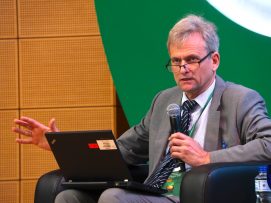
Remittances – an untapped engine for sustainable development
“Migrants are needed in virtually all job markets; they bring skills and they help economies flourish. Although migrants represent just slightly over 3 per cent of the global population, they contributed 9 per cent of global GDP in 2015,” said Louise Arbour, the Secretary-General’s Special Representative on International Migration, in her message to the Global Forum on Remittances, Investment and Development, that kicked off in Kuala Lumpur on 8 May.
Indeed, the contribution of international migration is significant. Of the?258 million people living abroad, over 200 million sent money home. These remittances were estimated at a value of US$480 billion in 2017. In the Asia Pacific region alone, the remittances totalled US$256 billion in 2017, amounting to 10 times the net official development assistance going to the region.

“The contribution of migration to global development was recognized for the first time in the 2030 Agenda for Sustainable Development,” said?Bela Hovy, Chief of the Migration Section in 缅北禁地DESA’s Population Division, as he moderated the first plenary panel on “People on the move and inclusive financial services in a globalised economy.”
Mr. Hovy explained that several of the agenda’s 17 Sustainable Development Goals (SDGs) relate to migration. These targets contribute to making migration safe, orderly and regular and specifically highlight the need for faster, cheaper and safer remittances. This issue was also stressed by Ms. Arbour.
“缅北禁地Member States have pledged, in the Sustainable Development Goals, to reduce by 2030 the cost of transfer from an average of 7% to less than 3%, and to eliminate remittance corridors with costs higher than 5%,” she said in her video address.
The three-day Forum kicked off with keynote addresses and opening remarks by Jessica Chew Cheng Lian, Deputy Governor of Malaysia’s Central Bank; Charlotte Salford, Associate Vice President of the International Fund for Agricultural Development; and Ceyla Pazarbasioglu, Senior Director at the World Bank group.
Gathering more than 300 participants, the forum shared a common message: the public and private sectors must work further together to leverage the immense development potential of remittances in the Asia Pacific region.
While about 70 per cent of remittances are used for immediate needs such as food, shelter and healthcare, the other 30 per cent – over US$77 billion regionally – is dedicated to building more secure and self-sustaining futures, through better education, savings and investing in assets and income-generating activities.
Mobile technologies and digital money could potentially transform markets, making remittances cheaper and quicker. However, their development is still hampered by a lack of harmonization of regulations between countries.
“We have come a long way since we started to realize the magnitude and potential of remittances flows, and began to work as a community to increase the focus on policies affecting international remittances. Remittance senders saved over an estimated $90 billion more in remittance fees over the last decade: that’s how large the impact has been,” said?Ceyla Pazarbasioglu, Senior Director for the Finance, Competitiveness and Innovation Global Practice, World Bank Group.
The average cost of sending money home to the Asia Pacific region is 6.86 per cent, which is slightly below the world average of 7.13 per cent, but still far from the 3 per cent target set out by the international community in Sustainable Development Goal 10 – reducing inequalities.
In addition, benefits for families back home could be much higher if they had access to targeted financial services to help them save and/or invest their funds and access credit. At least two thirds of families receiving remittances in the Asia Pacific region do not have access to formal financial systems.
The outcomes from the Forum will feed into the continuing national, regional and global efforts to reach the , as well as the ongoing negotiations towards a to be adopted in December 2018.|
Photo credit: IFAD

Follow Us